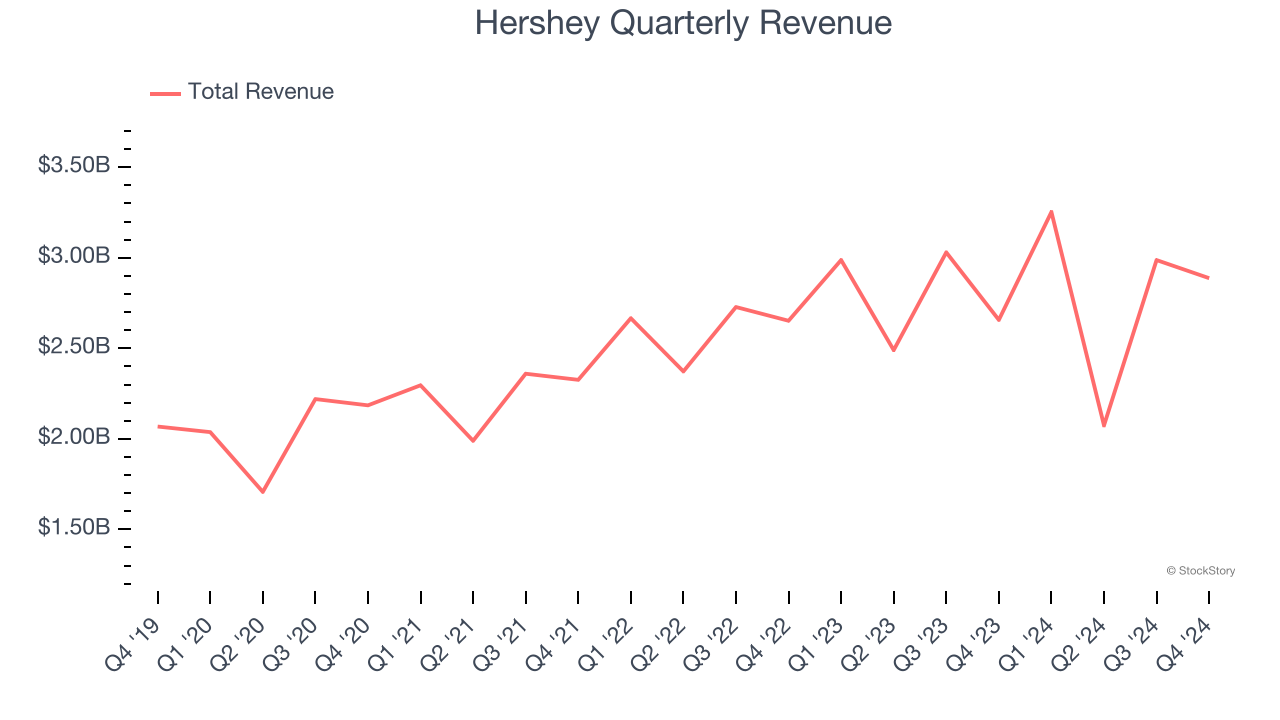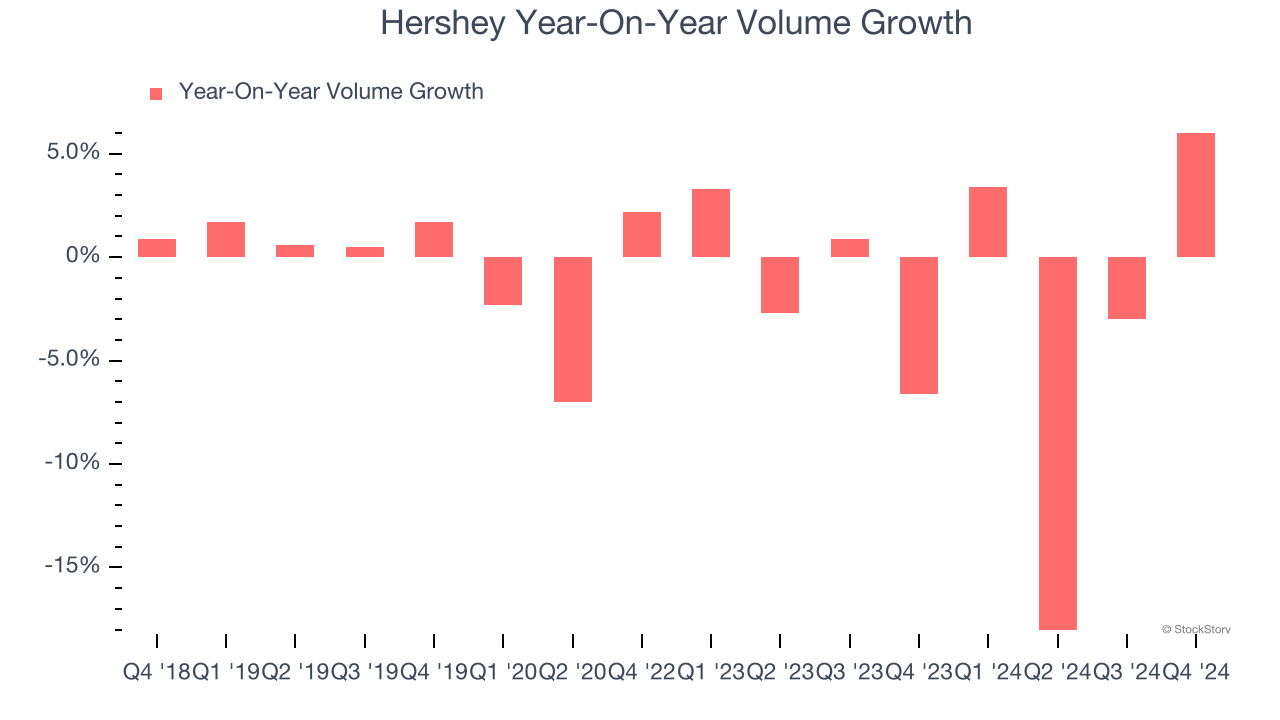
Chocolate company Hershey (NYSE:HSY) reported revenue ahead of Wall Street’s expectations in Q4 CY2024, with sales up 8.7% year on year to $2.89 billion. Its non-GAAP profit of $2.69 per share was 13.3% above analysts’ consensus estimates.
Is now the time to buy Hershey? Find out by accessing our full research report, it’s free.
Hershey (HSY) Q4 CY2024 Highlights:
- Revenue: $2.89 billion vs analyst estimates of $2.84 billion (8.7% year-on-year growth, 1.6% beat)
- Adjusted EPS: $2.69 vs analyst estimates of $2.38 (13.3% beat)
- Operating Margin: 32.5%, up from 17.5% in the same quarter last year
- Organic Revenue rose 9% year on year (-0.1% in the same quarter last year)
- Sales Volumes rose 6% year on year (-6.6% in the same quarter last year)
- Market Capitalization: $29.53 billion
Company Overview
Best known for its milk chocolate bar and Hershey's Kisses, Hershey (NYSE:HSY) is an iconic company known for its chocolate products.
Shelf-Stable Food
As America industrialized and moved away from an agricultural economy, people faced more demands on their time. Packaged foods emerged as a solution offering convenience to the evolving American family, whether it be canned goods or snacks. Today, Americans seek brands that are high in quality, reliable, and reasonably priced. Furthermore, there's a growing emphasis on health-conscious and sustainable food options. Packaged food stocks are considered resilient investments. People always need to eat, so these companies can enjoy consistent demand as long as they stay on top of changing consumer preferences. The industry spans from multinational corporations to smaller specialized firms and is subject to food safety and labeling regulations.
Sales Growth
Reviewing a company’s long-term sales performance reveals insights into its quality. Any business can have short-term success, but a top-tier one grows for years.
With $11.2 billion in revenue over the past 12 months, Hershey is one of the larger consumer staples companies and benefits from a well-known brand that influences consumer purchasing decisions.
As you can see below, Hershey’s 7.7% annualized revenue growth over the last three years was decent despite consumers buying less of its products. We’ll explore what this means in the "Volume Growth" section.

This quarter, Hershey reported year-on-year revenue growth of 8.7%, and its $2.89 billion of revenue exceeded Wall Street’s estimates by 1.6%.
Looking ahead, sell-side analysts expect revenue to grow 1.6% over the next 12 months, a deceleration versus the last three years. This projection doesn't excite us and indicates its products will face some demand challenges. At least the company is tracking well in other measures of financial health.
Software is eating the world and there is virtually no industry left that has been untouched by it. That drives increasing demand for tools helping software developers do their jobs, whether it be monitoring critical cloud infrastructure, integrating audio and video functionality, or ensuring smooth content streaming. Click here to access a free report on our 3 favorite stocks to play this generational megatrend.
Volume Growth
Revenue growth can be broken down into changes in price and volume (the number of units sold). While both are important, volume is the lifeblood of a successful staples business as there’s a ceiling to what consumers will pay for everyday goods; they can always trade down to non-branded products if the branded versions are too expensive.
To analyze whether Hershey generated its growth from changes in price or volume, we can compare its volume growth to its organic revenue growth, which excludes non-fundamental impacts on company financials like mergers and currency fluctuations.
Over the last two years, Hershey’s average quarterly sales volumes have shrunk by 2.1%. This decrease isn’t ideal as the quantity demanded for consumer staples products is typically stable. Luckily, Hershey was able to offset fewer customers purchasing its products by charging higher prices, enabling it to generate 3.4% average organic revenue growth. We hope the company can grow its volumes soon, however, as consistent price increases (on top of inflation) aren’t sustainable over the long term unless the business is really really special.

In Hershey’s Q4 2024, sales volumes jumped 6% year on year. This result was a well-appreciated turnaround from its historical levels, showing the company is heading in the right direction.
Key Takeaways from Hershey’s Q4 Results
We were impressed by how significantly Hershey blew past analysts’ gross margin expectations this quarter. We were also happy its organic revenue outperformed Wall Street’s estimates. Overall, we think this was a decent quarter with some key metrics above expectations. The stock traded up 3% to $150.26 immediately following the results.
Hershey had an encouraging quarter, but one earnings result doesn’t necessarily make the stock a buy. Let’s see if this is a good investment. What happened in the latest quarter matters, but not as much as longer-term business quality and valuation, when deciding whether to invest in this stock. We cover that in our actionable full research report which you can read here, it’s free.
